Search Results

- IDNO:
- 041165
- Title:
- German Civilians Seek Shelter, Tenholz, Germany
- Date:
- ca. 1945
- Description:
- Caption on back of photo reads: "German civilians from the small farming community of Tenholz are received by an American soldier in a shattered house serving as a reception center in Lovenich. The 102nd Infantry Division of the Ninth U.S. Army captured Lovenich February 25, 1945."
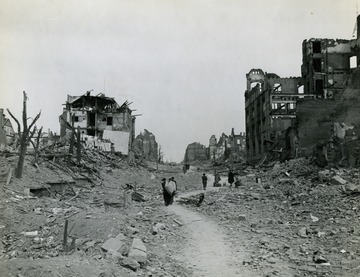
- IDNO:
- 041166
- Title:
- Destruction of Plauen, Germany
- Date:
- ca. 1945
- Description:
- Caption on back reads "Civilians of Plauen, Germany, make their way through rubble filled streets in search of what articles they can salvage from their wrecked homes and shops. The city was captured by the 3rd U.S. Army following a devastating attack by Allied bombers."
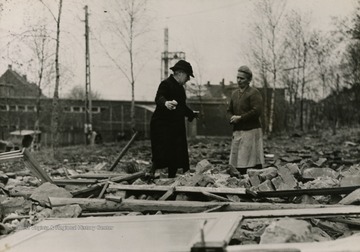
- IDNO:
- 041167
- Title:
- German Shell Causes Casualties in Reich, Germany
- Date:
- ca. 1945
- Description:
- Caption on back of photo reads: "German woman (left) stands before the wreckage of her home and explains to a neighbor how a heavy Nazi shell leveled the building. Several civilians were injured by the enemy action against the town after its capture by American troops."
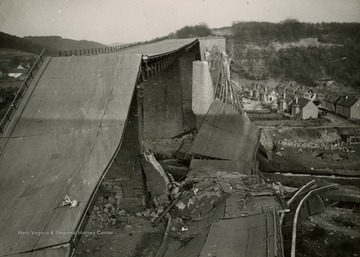
- IDNO:
- 041168
- Title:
- Germans Blow Up Autobahn Bridge, Kaiserslautern, Germany
- Date:
- ca. 1945
- Description:
- Information on back of photo reads: "This bridge, part of the German autobahn highway near Kaiserslautern, was blown up by fleeing Nazi troops during the advance of American forces inside the Saar bulge. Kaiserslautern, road junction town in the area, was entered by the Third U.S. Army troops March 20, 1945. The autobahn is the many-laned concrete highway designed to link up most of Germany in a network. The system had not been entirely completed by the Nazis at the outbreak of the war."
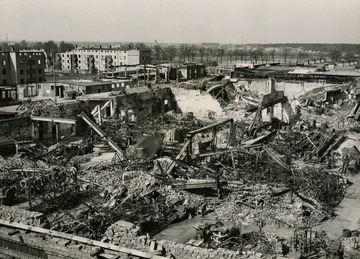
- IDNO:
- 041169
- Title:
- German Tire Plant Reduced to Rubble, Hanau, Germany
- Date:
- ca. 1945
- Description:
- Information on back of photo reads: "Rubble and bombed out buildings are all that remain of the plant of the Dunlop Company at Hanau, which was Germany's second largest tire plant. This factory specialized in aircraft tired before it was mombed out of existence by Allied air attacks. Twenty-eight miles east of the Rhine and eight miles east of Frankfurt, Hanau was cleared by troops of the Third U.S. Army March 27,1945."

- IDNO:
- 041170
- Title:
- Civilians Leave Aachen, Germany
- Date:
- ca. 1945
- Description:
- Information on back of photo reads: "Clutching a few personal belongings, German civilians pass through the blazing streets of Aachen en route to the safety of First U.S. Army lines. Most of the 3,000 civilians who managed to leave the Reich border city by October 14, 1944, were old men, weeping women, and children. American bombs and shells began turning Aachen into a blazing inferno when the surrounded Nazi garrison refused to surrender under penalty of destruction of the city."
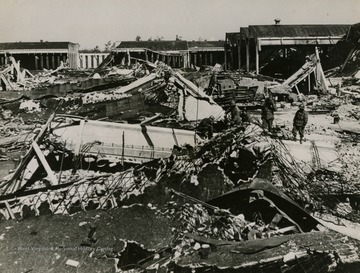
- IDNO:
- 041171
- Title:
- Allied Air Attacks Knock Out Nazi War Plant, Fallersleben, Germany
- Date:
- ca. 1945
- Description:
- Information on the back of photo reads: "This is all that remained of the famous Nazi Volkswagen factory at Fallersleben, Germany, when U.S. Army ground forces captured the town following four daylight attacks on the plant by bombers of the Eighth U.S. Air Force and the British Royal Air Force. Prior to the attacks, 18,000 employees worked here but this figure fell to 7,000 after the first Allied visits. Later, work in the factory came to a complete halt. Only 40 workers were killed during the bombings because of air raid shelters. The plant was originally built by the Deutsche Arbeiter Front (German Labor Part) in 1938-39 to produce the "people's car", or Volkswagen, for sale to the German people at about 900 marks ($360). After it was completed, the German High Command converted it to jeep and mine production. Before the Allied air attacks, the plant was capable of monthly production of 1,800 kubelwagen (jeeps), 1,000 amphibious jeeps, 1,200 V-1 bombs, 100,00 Teller mines and the repair of 30 Ju-88 aircraft wings."
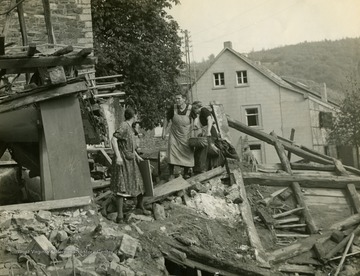
- IDNO:
- 041172
- Title:
- German Citizens Walk Through Rubble, Weifall, Germany
- Date:
- ca. 1945
- Description:
- Information on back of photo reads: "German civilians look over the ruins of their home which was shelled by American troops in the attack on Weifall, Germany."
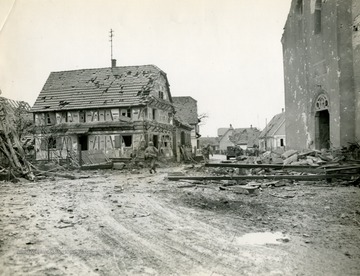
- IDNO:
- 041173
- Title:
- American Infantrymen in Battle Scarred Rohrwiller, France
- Date:
- ca. 1945
- Description:
- Caption on back of photo reads: "American infantrymen of 36th Division run through rubble littered street of battle-scarred Rohrwiller, France. Town is under enemy attack."
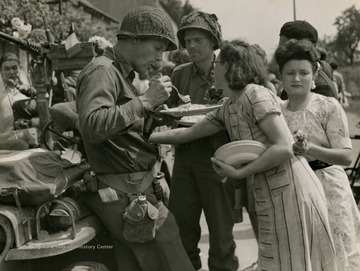
- IDNO:
- 041174
- Title:
- Captain Philip Staples Receives Egg Omelette From French Civilians
- Date:
- ca. 1945
- Description:
- Information on back of photo reads: "Capt. Philip Staples; Ardmore, Pennsylvania enjoys a fresh made egg omelette that was presented to him by grateful French civilians who had just been liberated from German hands, near Champagne."
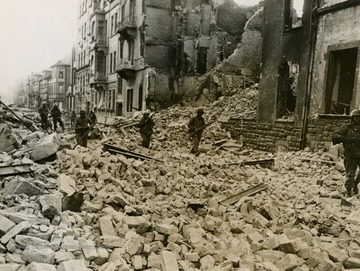
- IDNO:
- 041175
- Title:
- U.S. Soldiers Capture Worms, Germany
- Date:
- ca. 1945
- Description:
- Information on the back of photo reads: "Infantrymen of the Fourth Armored Division, Third U.S. Army, advance through rubble in a battered street in Worms, Germany, as they clear out Nazi snipers in the captured city March 20, 1945. Worms is on the west bank of the Rhine River nine miles north of Ludwigshafen."
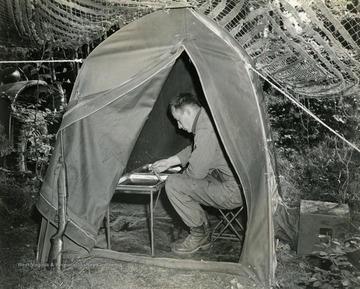
- IDNO:
- 041176
- Title:
- U.S. Soldier in Tent 'Dark Room' in European Theater of Operation
- Date:
- ca. 1945
- Description:
- The soldier is most likely Raymond Young, infantry man and combat photographer, United States Third Army. Young is using his tent as a photo lab to develop film while on the front lines.











